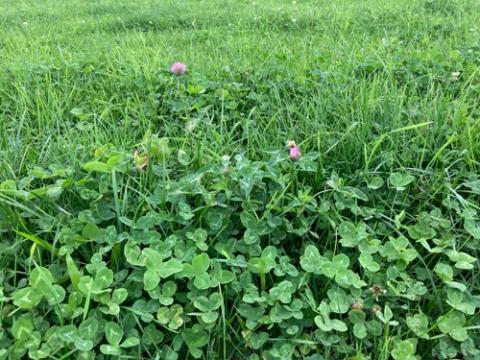The group hope to inspire others to reap the benefits from growing red clover by challenging and updating 50-year-old research from Australia and New Zealand.
This older research found fertility can be impacted when ewes are grazed exclusively on red clover, as the plant contains phyto-oestrogens. But this winter these farmers, based in the West Midlands and Powys, grazed their sheep on herbal leys with an average of 17.6% red clover -resulting in positive rather than negative impacts.
What farmers found out about grazing red clover leys
Triallist Marc Jones, who farms sheep and beef cattle across 700 acres in Powys, said: “We’ve been putting ewes on leys with red clover for six or seven years now and although we’ve never seen any negative impacts, we wanted to have some evidence to back it up. “A lot of farmers are hesitant about giving it a go, but the original research was done so long ago and with ewes grazing pure red clover, which is not how we use it.
“We’ve been able to prove that growing it alongside other herbs and legumes does have higher digestibility for the ewes, without impacting pregnancy scanning rates. It’s a good technique for flushing the sheep and for finishing lambs – and young cattle also do well on it. We do different tests and trials every year but putting some figures to it with research done on real farms makes a huge difference.”
Red clover has an unexpected positive effect on sheep fertility
The field lab involved selecting a group of ewes for the trial and splitting them into two halves. One half was grazed on grass leys with no red clover, and the other was grazed on herbal leys containing the legume. Most triallists had already established red clover on farm, but one introduced it as a new sward in Summer 2021. On average the ewes in the control group scanned at 170%, while the ewes mated on swards containing red clover scanned at 181%.
Gillian Preece, a sheep farmer and senior consultant at ADAS, who is coordinating the field lab trial, said: “It’s clear to see there are no negative results from grazing ewes on red clover, and that farmers can have confidence in this practice.
“The ewes that mated on the red clover actually scanned higher – this was unexpected because we were setting out to prove no negative effect and what we ended up with was a positive effect. We want to encourage a wider uptake and less fear across the industry, especially as it’s such a good plant for nitrogen fixing."
“This field lab was great for spreading knowledge as the farmers didn’t know each other before and are geographically spread out, so they are all able to share findings with each other and then take it back to their local areas.”
She explained that the positive result will likely have been due to the sheep eating a more diverse diet as the herbal ley contained a variety of other plants including chicory, plantain, and wildflowers, which are good for nutrition.
Nitrogen fixing and environmental benefits of red clover
As red clover is more effective at fixing nitrogen in soils than its relative white clover, it could also be a good option for farmers looking for alternatives to artificial fertiliser. Mr Jones added that it’s also a good drought resistant crop.
He said: “We don’t get any Stewardship payments for red clover in Wales, so we are doing it purely for business purposes. The more red clover we can use the better – it’s helped us to really cut back on nitrogen costs and it’s also good for drought resistance. We farm in a dry spot which has the same average rainfall as Cambridge and it’s been really dry for the last four or five years – we’ve had to make some rapid changes. Red clover is deep rooting so it means our pastures hold up better and it’s giving us nitrogen at the same time."
“We started off with just 20 acres using red clover and have gradually increased it over the years, which has helped us to decrease that dependency on nitrogen. Without the legumes we would be looking at paying huge costs this year – we would have gone from £35,000 last year to £90,000 this year.”
Encouraging farmers to have a go at establishing red clover
Mrs Preece added that as red clover establishes quickly, farmers could sow it this spring and graze sheep on it as early as late June. She explained that it can be incorporated into existing pasture or sown within a new grass or herbal ley to fix nitrogen following a previous arable crop or as a grass reseed.
Innovative Farmers Manager Rebecca Swinn said: “Farmers have a right to demand appropriate research, so it has been great to support this group. They challenged existing research which didn’t apply to the majority of real-life farming situations, and I hope the results encourage more farm businesses to integrate red clover and reap its many benefits.”
The triallists are among the 12,000 UK farmers that the Innovative Farmers has connected with since 2012. Now in its 10th anniversary year, the network has co-ordinated more than 120 field labs that have placed farmers in the driving seat of agricultural research.
Trial facts and figures
• Both groups were grazed for three weeks before tupping and throughout the mating season, and they were then scanned for pregnancies.
• The swards were also assessed for clover content, with fresh weight samples taken when the sheep are initially put on the fields, when the rams are put in, and when the mating period ended.
• Three out of four of the farms already had red clover established, with the sheep grazing swards in their second or third year.
• Seed mixes containing 10% red clover were used for each sward, which resulted in fresh weight samples showing an average of 17.6% red clover.
• The highest red clover percentage found in the fresh weight samples was 36.9%. This was only found on the one farm that grazed sheep on the red clover in its first year.
• Red clover rates in fresh weight samples are usually higher in the first year, with the plant usually being outcompeted by white clover as the sward gets older.



